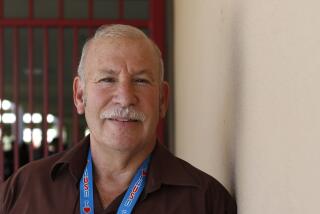. . . Then Again, There’s Plenty for a Mayor to Do
While the Los Angeles mayoral candidates have been talking about education, the conventional wisdom is that whoever is mayor really can’t do a thing about our schools.
The conventional wisdom is wrong: The city government actually has plenty of authority over the schools.
Urban school systems are usually governed by a small universe of school boards, school bureaucracies and teacher unions. Frustrated, voters have turned to mayors and city councils to hold failing schools accountable. As a result, city governments across the nation have become more involved in school governance. In Boston, Chicago, Oakland and even as close as Pasadena, city governments have taken the lead in school reform.
While former Mayor Tom Bradley sidestepped the bitterly divisive debate over school busing, he also took the first steps toward greater involvement. He allocated Community Redevelopment Agency funding for an ambitious and successful after-school program. He quietly helped the schools raise money, in one case by putting a school board member together with a financier and future mayor--Richard Riordan--to obtain a big donation for classroom computers.
Mayor Riordan has gone much further by creating an organized group to pursue education reform and by endorsing and financing reform candidates in school board elections.
Before Riordan, the most realistic way to win a school board seat was by getting the endorsement of the teachers’ union; now there is an alternative make-or-break endorsement. Riordan deserves considerable credit for forcing open a hitherto closed system of school board politics.
But something more durable and comprehensive than dueling campaign organizations is needed. The most effective boards of education have members whose independence from political organizations allows a single-minded focus on what’s best for education. When victory depends on winning an endorsement of one of the two main combatants, the chances of such independence are diminished, and polarized school politics are inevitable.
There is another way. A publicly accountable process of school reform should be undertaken, and the City Charter gives the city government the authority to do it. While state law and the charter vest the operation of the schools in the Board of Education, the charter determines the structure of how the district is governed. The City Charter determines whether the school board is elected or appointed; the board’s size; whether there will be term limits for board members; whether members will be elected by district or at large; and whether board members will be compensated at a level greater than that set by state law.
All voters in the Los Angeles Unified School District are entitled to vote on any charter changes involving the schools. In fact, the current method of electing school board members by district was established by a charter amendment passed by LAUSD voters in 1978. In 1999, the two commissions that developed the new City Charter decided to retain the charter’s authority over schools.
That decision preserved the city government’s leverage in education. The next mayor can be a thoughtful voice, both challenging and empowering the school board to do the best, most independent job it can. The mayor can investigate how the district is governed in the sunlight of public input and discussion. The city can look for ways to work more cooperatively with the school district, especially in the area of school construction. It may even be wise to institutionalize the relationship and dilute electoral wars by authorizing the mayor to appoint additional board members from a list supplied by a blue-ribbon citizen’s commission.
Mayoral involvement in the schools can open up an array of alternative reforms beyond simply breaking up the school district or piecemeal policy changes. Breakup may well emerge as the way to go, but a breakup without an exploration of what works and what doesn’t may only create a series of smaller, dysfunctional districts.
In any case, a thoughtful, tough educational agenda can help the next mayor show that city government can respond effectively to the problems the voters want addressed. In the long run, that is the best antidote to secession.
More to Read
Sign up for Essential California
The most important California stories and recommendations in your inbox every morning.
You may occasionally receive promotional content from the Los Angeles Times.










